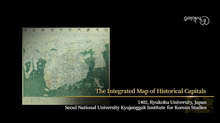The Story of Culture and Arts
- Image resource of Korean history
- Documents from History TextBooks
- Culture & Art Stories from Korean History
- Culture & Art Stories from Korean History - Korean
- National Institute of Korean History
- History net
- About the site
- Introduce
-
Numerous topics related to Korean culture and art are mentioned in middle and high school national history textbooks, but most of them are briefly described by era, making it difficult to understand their concepts, transition processes, and characteristics.
<Culture & Art Stories from Korean History> produces and provides video materials based on expert commentary on the flow, change process, characteristics and characteristics of each major topic in the field of culture and art in Korean history.

Scenario
The Korean keyboard layout used today is divided into two sections: consonants on the left and vowels on the right. This layout can be found on all digital devices, such as smartphones, for easy input. This layout originated from the Korean typewriter.
The Korean typewriter was the predecessor to the Korean computer keyboard and the start of Hangeul’s mechanization. It first came about by implanting Hangeul, or Korean characters, on to a standard American typewriter.
Hangeul is a phonetic alphabet with a set number of vowels and consonants. As such, Hangeul easily adapts to typewriters, just like other alphabetic typing systems using the Roman alphabet.
But how did countries like Japan and China that use Chinese characters type?
In China, various character-based typewriters were created but difficult to use. One interesting device pieced radicals together to create a single character.
Japan created a printing press-style typewriter featuring over 2,000 characters they had to individually find and press. It lacked efficiency compared to Roman alphabet typewriters.
Nevertheless, the process of commercializing a Hangeul typewriter took work. Although Hangeul is a phonetic alphabet, it has initial, middle, and final letters that are combined to create a single-syllable character. Furthermore, sentences were usually written vertically. And Korean also used Chinese characters. Many issues needed to be resolved.
The Hidden History of the Invention of the Korean Typewriter
After Korea’s liberation from Japan, officially switching to writing horizontally and in Hangeul solved two problems, but one problem still remained. In 1949, two types of typewriters were developed.
Dr. Gong Byung-woo, an optometrist, developed the three-set typewriter. The keyboard was arranged according to Hangeul’s principle of an initial, middle, and final letter and boasted quick typing speeds.
By 1965, the Gong Byung-woo Typewriter lead the Korean typewriter market after selling nearly 30,000 units. However, characters were uneven, and they could be altered later to add final consonants. As a result, five-set keyboards were preferred for writing something requiring a neater font, such as official documents.
The layout consisted of two sets of initial letters, two sets of middle letters, and one set of final letters, resulting in slightly slower typing speeds but cleaner writing.
Thus, various keyboard layouts were developed to make up for the two models’ flaws, and by the 1960s, when demand soared due to the country’s industrialization, nearly 13 different models were on the market.
But more isn’t always better. None of the typewriters were cross-compatible, and users began expressing frustration. To solve this, in 1969, the Korean government decided the 4-set keyboard would become the standard.
Initial and final consonants were each one set, and vowels were two sets, for a total of four. The four-set design allowed for quicker typing than the five-set, but people noticed the issues with the three- and four-set designs were not addressed. So, debates continued even after this standardization.
Following the mass adoption of computers, in 1983, the four-set keyboard was discarded and the two-set Hangeul keyboard we use today became the new standard.
[Epilogue]
The intense development process of the Korean typewriter involving several inventors and Korean linguists. Those efforts were the foundation for the digitization of Hangeul and its use in the current digital age.
-------------------------------------
Advisor: Kim Taeho
Script/Storyboard: Im Seung-yeon
Editor: Myung Jaerim, Seo Myungwon
Narrator: Mary Katherine Chadwick
Filming: Yoon Suwon
General Editing: Park Injoon, Lee Seungsin
Illustrations: Kim Jongseok, Shim Hui-young
Recording/Music: Jo Donghyo
Logo: Min Seung-ook
Materials/Resources: National Hangeul Museum, National Archives of Korea, KTV
English Translation & Editing: Mary Katherine Chadwick, Daniel Kane, Lee Jaeyeol
Production Manager: Yoon Jongwon, Kim Kiwon
Administration: Kim Sanghee
Director: Kim Kiwon
Science and technology, Communication
10 films-
 Korean Typewriter04:37
Korean Typewriter04:37 -
 Beacon Towers09:30
Beacon Towers09:30 -
 The Bow08:36
The Bow08:36 -
 Ballistic Weapons09:06
Ballistic Weapons09:06 -
 Ships in Traditional Korea09:04
Ships in Traditional Korea09:04 -
 Papermaking and Printing Techniques09:03
Papermaking and Printing Techniques09:03 -
 Astronomical Instruments and Calendars During King Sejong’s Reign08:50
Astronomical Instruments and Calendars During King Sejong’s Reign08:50 -
 Honil Gangni Yeokdae Gukdo Ji Do02:18
Honil Gangni Yeokdae Gukdo Ji Do02:18 -
 Daedongyeojido04:07
Daedongyeojido04:07 -
 Old Maps in Korea08:24
Old Maps in Korea08:24

